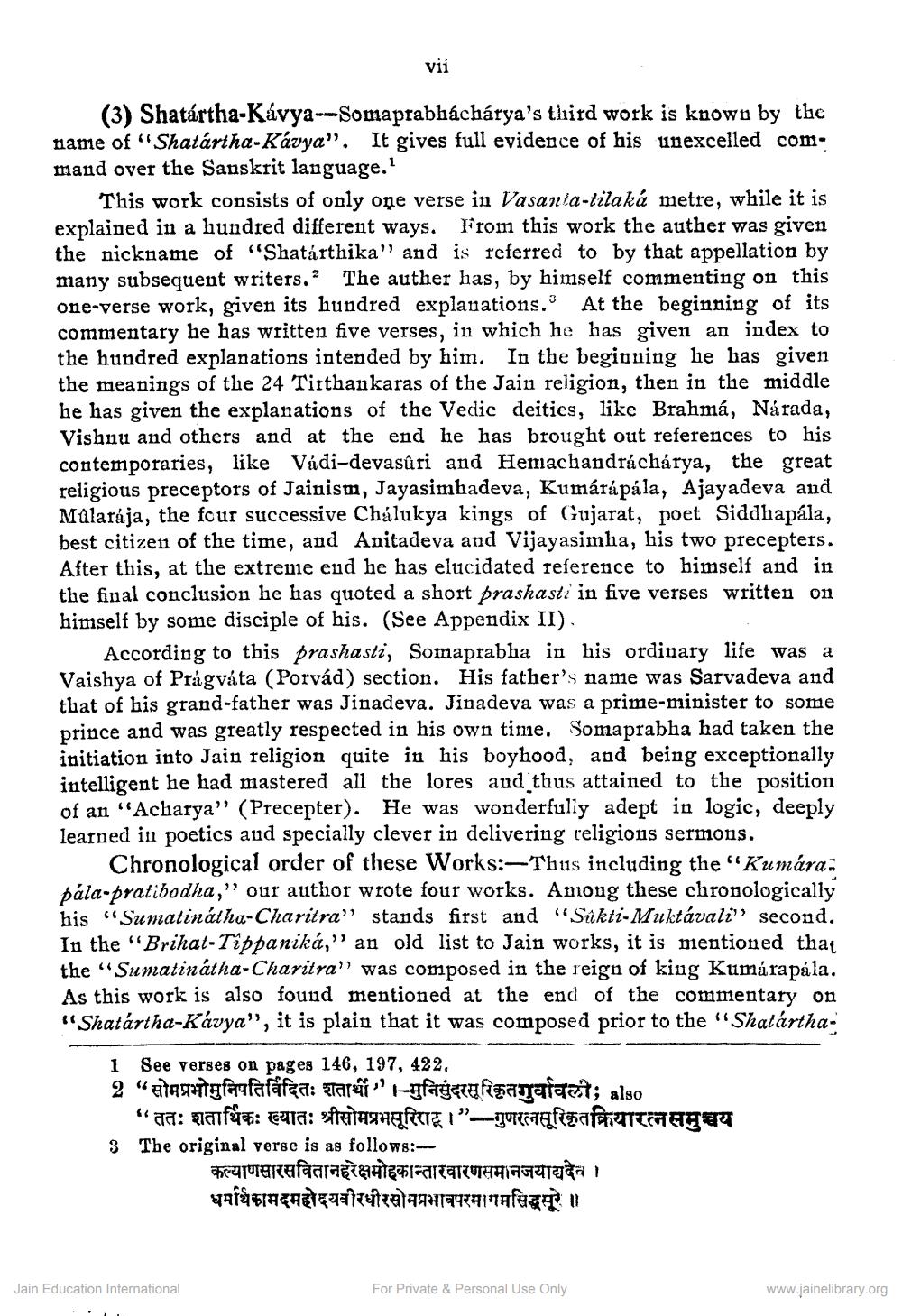________________
vii
(3) Shatártha-Kávya-Somaprabháchárya's third work is known by the name of "Shatártha-Kavya". It gives full evidence of his unexcelled command over the Sanskrit language.
This work consists of only one verse in Vasanta-tilaká metre, while it is explained in a hundred different ways. From this work the auther was given the nickname of “Shatárthika” and is referred to by that appellation by many subsequent writers. The auther has, by himself commenting on this one-verse work, given its hundred explanations. At the beginning of its commentary he has written five verses, in which he has given an index to the hundred explanations intended by him. In the beginning he has given the meanings of the 24 Tirthankaras of the Jain religion, then in the middle he has given the explanations of the Vedic deities, like Brahma, Narada, Vishnu and others and at the end he has brought out references to his contemporaries, like Vádi-devasûri and Hemachandracharya, the great religious preceptors of Jainism, Jayasimhadeva, Kumárápála, Ajayadeva and Malarája, the four successive Chalukya kings of Gujarat, poet Siddhapala, best citizen of the time, and Anitadeva and Vijayasimha, his two precepters. After this, at the extreme end he has elucidated reference to himself and in the final conclusion he has quoted a short prashasti in five verses written on himself by some disciple of his. (See Appendix II)
According to this prashasti, Somaprabha in his ordinary life was a Vaishya of Prágváta (Porvád) section. His father's name was Sarvadeva and that of his grand-father was Jinadeva. Jinadeva was a prime-minister to some prince and was greatly respected in his own time. Somaprabha had taken the initiation into Jain religion quite in his boyhood, and being exceptionally intelligent he had mastered all the lores and thus attained to the position of an "Acharya” (Precepter). He was wonderfully adept in logic, deeply learned in poetics and specially clever in delivering religious sermons.
Chronological order of these Works:—Thus including the "Kumara: pála-pratibodha," our author wrote four works. Anong these chronologically his "Sumatinátha-Charitra" stands first and "Sukti-Muktavali's second. In the "Brihal-Tippaniká," an old list to Jain works, it is mentioned that the "Sumatinátha-Charitra'' was composed in the reign of kiug Kumarapála. As this work is also found mentioned at the end of the commentary on "Shatártha-Kavya”, it is plain that it was composed prior to the “Shatártha
1 See verses on pages 146, 197, 422,
2 “Alasagfarafaráfea: starali" 1g fargelangagafacit; also __"ततः शतार्थिकः ख्यातः श्रीसोमप्रभसूरिराटू।"-गुणरत्नसूरिकृतक्रियारत्नसमुच्चय 3 The original verse is as follows:
कल्याणसारसवितानहरेक्षमोहकान्तारवारणसमानजयाद्यदेव । धर्मार्थकामदमहोदयवीरधीरसोमप्रभावपरमागमसिद्धसूरे॥
Jain Education International
For Private & Personal Use Only
www.jainelibrary.org




